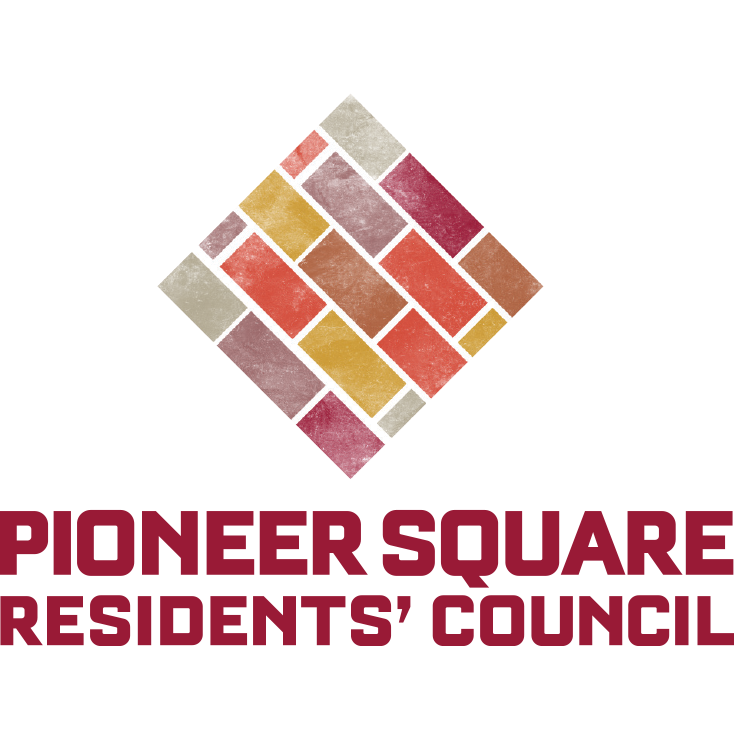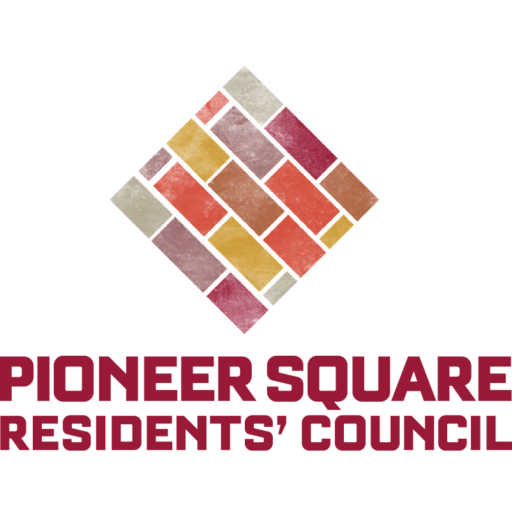16 Nov P2 – a joke to surrounding neighborhoods? Or accurate perception?
The post I did about the new banners for P2 was recently highlighted in The Stranger (link). My first reaction to it was a negative one. Instead of the usual sarcastic commentary about “what are the banners going to do” or “maybe banner will help stop the drug problem,” here is the main criticism of the banners in this short post:

As you read through the comments to this post, here are some of the other highlights:
“Poor people shmoor people! I’d love to take a camping vacation the rest of my life. the only reason I dont is that chicks dont dig it”
“It’s to execute brilliant ideas such as this that I wish I was an impossibly wealthy man. Mr. Hughes would have funding for his banner and panels in two shakes of a fortified wine bottle.”
After first reading it, the Husband suggested I write about the fact that other neighborhoods think that Pioneer Square is a joke. Something along the lines of the problems that we’re facing are something to laugh about — mainly the abundance of homelessness in the region.
There are other comments that ‘defend’ the square, such as:
“It would help if the actual homeless were allowed a place to live, like in Portland’s Dignity Village. Instead, we just have the police harass the homeless unless there’s a critical mass of them in a visible park or pushed around every few months in a tent city.”
[for other (c)rude comments, you’ll have to go read the post yourself]
It does bring up an important conversation, though, related to Friday’s post. Do we actually have a problem in Pioneer Square? Or is the problem the negative perception people have of Pioneer Square?
Currently, it is an accurate statement that a banner with “homeless district” is fitting for P2. If you’ve read previous posts, you know that I don’t have a problem with homeless people. At least not the ones who seem to care about the neighborhood. The problem that I have is that the services are so heavily concentrated in our little square. It’s part of the reason I think Lazarus should move — as one of the most disruptive, disorderly homeless organizations in the neighborhood — it’s a start for reducing the concentration that leads to the homeless people and drug dealers outnumbering the residents.
I’m going to go off of the topic of Pioneer Square for a bit, although everything below is very relevant to our problem. I don’t want this blog to become a campaign surrounding homelessness. However, there are some serious issues that need to be addressed when it comes to solving some of the problems of the neighborhood. It begs another question: what is working in other cities? Would it work here?
In addition to the very well known program in NY flying the homeless out of the city, there is an interesting study that was recently completed in NYC by a local Architectural Design firm. They spent three years studying the cycle of homelessness in a project they call “Private/Public.” One of the conclusions they drew for their city is the same that John, my homeless friend, told me for the homeless in Seattle:
“less than 10 percent of this population resides in the public spaces of the city typically associated with sites of homelessness: the street, the subway, abandoned lots.”
and
“the majority of New York’s homeless are families living in the city’s shelter system, invisible to the public”
They’ve included many programs in NYC to combat homelessness, from funding emergency shelters and relief initiatives — solutions that are only considered “temporary solutions”– to flying them back to where they came from, a more permanent solution with a lower investment.
Or how about the Canadian’s (Surrey, BC) brilliant new plan for solving homelessness: city workers spreading chicken dung around a social services building and trees in a nearby park. They thought if the area smelled “less appealing to the homeless,” they would stay away from the area. Just think about this idea for a little while. (link)
There is an excellent article by Neal Peirce called “Homelessness in America: Finally, Glimmers of Hope.” It is stated that a positive thing that is currently happening in cities across America is that they are no longer trying to keep the homeless off the streets, clearing them out of public parks, or forbidding them to sleep on public sidewalks. All that that does is move the problem to another neighborhood.
One solution that has been suggested is to simply provide the homeless with a home. According to Housing and Urban Dev’t Secretary, Shaun Donovan, “it’s a myth that anyone wants to be homeless.” Providing them with services, such as overnight shelter, emergency medical services, food programs, easily run up massive public costs.
And what do these costs equal? Nothing. Because it doesn’t actually give them a place to live, making them all temporary solutions that are extremely expensive.
This article also highlights a project that I recently learned about from our community sergeant regarding homeless who are chronic alcoholics. When he first told me about it, I think I was appalled. (I can’t remember, but I’m pretty sure on the About Us page, I reference my lack of good memory). The more that I’ve learned about it, the more I think it’s the best solution I’ve heard yet.
For those of you who haven’t heard of it, the project is run by the Downtown Emergency Service Center and is called 1811 Eastlake. Their website states that they serve “75 formerly homeless men and women living with chronic alcohol addition.” I was initially appalled, I think, because I wasn’t sure how I felt about the city providing them with alcohol, essentially helping them drink themselves to death.
But look at some of the statistics from the program (and think about how this could be applied to the general homeless problem, and not just one dealing with chronic alcoholism).
Before 1811 Eastlake, residents:
— spent a collective 1,200 + days in jail
— visited the local medical center more than 1,100 times
Cost to taxpayers: $3.5 million
After the first year of 1811 Eastlake:
— days in jail were cut almost in half
— big reduction in hospital visits
Cost to taxpayers: down 40%
To read more about this program, and other federal strategies, read the article here.
Whew! Sorry for the long post.. I’ve been saving up some of those links. AND…. back to my original question.
Do I think that Pioneer Square is a joke to other neighborhoods? Maybe not a joke — but do the perceptions about the square have some accuracy to them? Is dealing with homeless and drugs something many other Seattle neighborhoods face? I think so (see my post where John’s answer to “where are you scared to go to in P2″ is …”Belltown”)
I think that Pioneer Square needs a little help coming up with a solution to this one. I’d be interested in whether or not anyone knows why all of the homeless shelters are crammed into a 3-4 blog radius, and how difficult it is to make changes to that.
Also, for the record, if people were free to “categorize” some of the other neighborhoods on banners any way they wanted, there would be some pretty interesting banners in Seattle. I can think of a few already…
p.s. I’ll be honest… I tried to google “how to make fun of capitol hill Seattle” to think of a good zinger but couldn’t find one. Off of a hint from MLIA’s website, I entered the same thing into “mystery google.” The result was Taylor University. So there Capitol Hill with your.. your.. Taylor University district.



Pingback:The New Pioneer Square- Interview with Elliott Bay Book Co – Blog Title
Posted at 14:33h, 05 December[…] shelter locations and history). People joke that of the new banners made for our neighborhood, a “homeless district” one should have also been created. And it’s a reality. And it’s hurting local businesses from operating and residents from […]
Pingback:The New Pioneer Square- Understanding Addiction – Blog Title
Posted at 13:23h, 15 January[…] — I only wish that there had been more conversation on changes that can be made locally. I have written about 1811 before (a project run by DESC), so I gave the Executive Director Bill Hobson a call. What started […]
Pingback:The New Pioneer Square- Revitalization Committee, Part 1: Social – Blog Title
Posted at 09:28h, 19 January[…] So let’s get it started with what seems to be the hottest topic for Pioneer Square: Social. This includes social service providers, homeless, drug dealers, and people’s perception of our neighborhood. […]